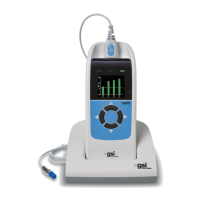Corti device provides an estimate of outer hair cell function over a
wide range of frequencies.
What Are TEOAEs?
Transient Evoked Otoacoustic Emissions (TEOAEs) are acoustic
signals that can be detected in the ear canal of a person with normal
outer hair cell function, subsequent to stimulation of the auditory
system with a series of wideband clicks.
The Corti instrument generates a series of clicks, directs them into the
ear canal, and then analyzes the spectrum of the returning signal,
separating the noise and emission. By using band pass filters, the
Corti device provides an estimate of outer hair cell function over a
wide range of frequencies.
What Do Otoacoustic Emission Results Tell Us?
The presence of otoacoustic emissions suggests normal outer hair cell
function, which in turn correlates to normal hearing. However, a
passing result using this instrument is not an indication that the full
auditory system is normal. Thus, a PASS result should not be allowed
to override other indications that hearing is not normal. A full
audiologic evaluation should be administered if concerns about
hearing sensitivity persist. A REFER test result should not be
assumed to be an indicator of a lack of auditory function or the
presence of pathology; however, it should be followed with full
audiologic diagnostic testing and/or medical evaluation as
appropriate.
What Frequency Range of Hearing is Estimated?
DPOAEs: Approximately 1 kHz to 12 kHz (depending on the
frequency range selected). TEOAEs: Roughly 500 Hz to 4 kHz.
How are the Results Stored and Reported?
When the Corti is set in its default settings, the instrument will store
the results from one patient (left and right ear) in its non-volatile
memory for subsequent printing. However, the Corti instrument is
capable of storing up to 250 test results. The results are displayed via
the LCD on the front of the device and are stored in the device’s
internal memory. After testing is completed, results can be printed
using the printer and/or exported to a computer. Test results are stored
in the non-volatile memory so the operator can delay printing until a
later time if desired.

